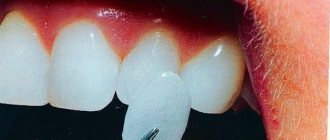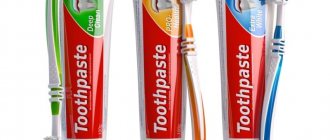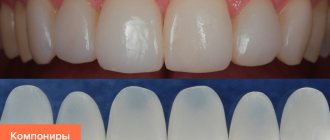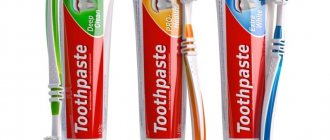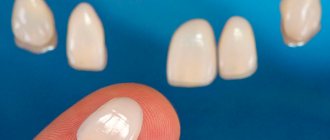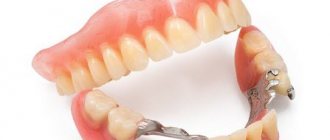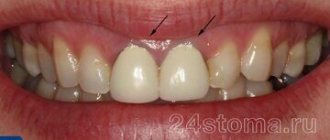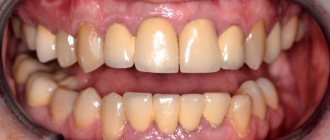06.07.2020
Today, aesthetic dentistry offers so many ways to restore teeth that, sitting in a chair at a doctor’s appointment, you can get confused. Patients often wonder what is better to choose: veneers or good old crowns? Unfortunately, in some clinics, patients are forced to undergo one or another procedure without bothering to list the strengths and weaknesses of both methods, as well as situations in which one or another method of dental restoration cannot be used. Sometimes, only after paying for the work done, a person learns that a crown could not have been installed, but could have been done with a more gentle procedure.
How to determine the appropriate method? What to expect from installation of veneers and crowns? We offer our clients to familiarize themselves with useful information regarding both methods.
What to choose for the restoration of the front row of teeth: crowns or veneers?
There are fundamental differences between veneers and crowns. Each type of restoration has its own characteristics and is used for varying degrees of damage to the dentition. Microprosthetics with veneers is a very popular and sought-after method of quickly transforming the front teeth. They are used only in the smile zone; outside of it, only crowns are placed. To decide what type of prosthetics to carry out: veneers or crowns, you need to know the purpose and functional features of the structures.
How are they different, help in choosing
Although both types of restoration visually create the same end result, they are very different in application. The most significant difference between veneers and crowns is the depth of treatment of enamel and dentin, because they are installed in different ways:
- crowns cover the entire tooth;
- veneers cover only the outer side (the one that is visible when a person smiles).
The tooth prepared for the prosthesis is greatly reduced in size and ground to a conical shape. The amount of reduction required is at least 2 mm (depending on the degree of damage). It is based on the fact that the standard crown wall thickness is 2 mm. However, this also depends on the type of materials. For example, metal ones are usually somewhat thinner.
When it comes to the benefits of veneers or ceramics, it is better to proceed from the facts, because they have an individual set of characteristics that are taken into account for the best choice. Pros and cons of crowns:
- Requires deep grinding.
- Due to the metal base they look less natural.
- Can be used to change color and shape more significantly.
- Used to restore and strengthen severely damaged teeth.
- Very strong, durable and the best choice for heavy chewing loads.
Crowns are used for large-scale restoration of severely damaged teeth. Veneers are usually used when minimal cosmetic interventions are required.
For example, they are used in the following cases:
- Used to change color (slight to moderate usually gives the most realistic results).
- You can slightly adjust the shape.
- Placed on healthy and undamaged teeth.
- Porcelain veneers most closely mimic natural teeth, but they are too fragile. They are usually installed in areas with relatively light and passive loads.
- Less traumatic, as they require little trimming; in some cases, they are installed without it.
- Once treated, a tooth will always need some type of coating.
Modern restoration materials meet the highest demands of beauty and functionality, although they have different structural characteristics. It is better to entrust the final decision in choosing between veneers or metal-ceramics to an experienced dentist, because the secret of an excellent result lies in his skillful hands, and an indicator of the perfection of technology is the natural and healthy appearance of teeth.
When is the best time to get veneers?
The installation of veneers involves covering the frontal group of teeth with the thinnest plates with a thickness of 0.2 to 0.7 mm. Veneers can be ceramic or composite; they are placed only on the front surface of the teeth, which makes the teeth beautiful and durable. Veneers are needed for those who have the following defects in the smile area:
- diastema (interdental gap)
- slight twisting, curvature and irregular shape of the tooth;
- the enamel has an uneven color, yellowness, spots, and all this cannot be bleached in the usual way;
- microcracks, chips;
- less than half of the teeth are destroyed;
- there are no significant shortcomings, I just want to have a Hollywood smile;
It should be especially noted that veneering is only possible if all the teeth in the row are present and they are not seriously damaged. The plates are attached to the native canine, so the tooth must have a sufficient layer of enamel and complete preservation of the lingual side. If this is not the case, you need to get crowns. Reasons for refusing to install veneers:
- Abnormal bite.
- Thinning enamel, severe tooth abrasion.
- Bruxism.
- Most of the tooth is destroyed or fillings have been placed on it.
- Passion for extreme sports.
To decide on the need to install veneers, you need to take into account contraindications and compare the veneered row of teeth and the usual one. The difference is noticeable, and the decision is made easier.
Contraindications
However, there are situations where it is not possible to apply such a procedure. First of all, this is the low strength of the teeth, installed large fillings, which do not allow the plates to adhere properly and act as protection.
Installation of veneers is not allowed in the following cases:
- bruxism, involuntary grinding of teeth during sleep;
- thin layer of enamel;
- the formation of the bite or its pathology has not been fully completed;
- caries in severe forms;
- unhealthy gums, the disease of which must first be cured.
When should crowns be placed?
If the veneer is a microprosthesis, then the crown is a single or double prosthesis (two prostheses are connected), which covers not only the front part of the tooth, but the entire tooth on all sides. Crowns are mounted on implants, pins, or prepared teeth.
The main task of a crown is to strengthen a tooth that is destroyed, maintain its anatomical shape and provide it with chewing function. Crowns are installed in the following cases.
- The hard tissues of the tooth are very damaged and cannot be restored using filling materials.
- In case of pathological abrasion of teeth to prevent further destruction.
- Elimination of serious defects such as uneven color, irregular tooth shape, abnormal growth.
- An abnormal bite that cannot be corrected with braces.
- Deep cracks and the presence of caries.
- If you have loose teeth or a large interdental gap.
Thus, if there is serious damage to the teeth, only crowns should be placed. There are no other possibilities.
Main differences
Both types of prostheses are used in orthopedic dentistry for prosthetic restoration of damaged elements.
Veneers are very thin sheets that are glued to the front surface of the damaged unit. They close the existing defect, so the smile begins to look aesthetically pleasing. However, they are not able to completely restore the functions of the tooth. They only replace its visible part to get a good visual result.
Dental crowns are restorations that cover the visible portion of an incisor/molar tooth. Outwardly, they resemble caps with thin walls. They are glued onto a previously prepared stump using special cement.
How to choose materials?
When it comes to the restoration of anterior teeth, in addition to the functional characteristics of the structures, the aesthetic side of the issue must be taken into account. Aesthetics is directly related to the quality of the material, and it is believed that veneers are better than crowns in this regard. This is partly true, but with the right selection of material and design, crowns will also look natural and beautiful. There is only one problem when installing crowns: choosing the right shade of dentures in accordance with the adjacent teeth. The task becomes easier if you replace the entire set of teeth at once, because the structure is made of one material. Metal-ceramic crowns. They are very popular due to the price-quality ratio, but in terms of aesthetics they are far from perfect. Characteristics of metal-ceramic crowns.
- There is a cosmetic effect, but the difference next to natural teeth most often remains noticeable.
- Reliable, durable. They can withstand serious loads; chipping is possible only under very strong mechanical stress.
- Service life up to 10 years.
- Depulpation is necessary and the dental tissue is subjected to significant grinding.
- Quite a reasonable price.
There are also crowns made of metal-free ceramics: zirconium and porcelain. They are inferior to metal-ceramics in terms of strength, but have higher aesthetic values. If a person does not put heavy loads on ceramic prosthetic teeth, they will last about 10 years.
Content
- What do crowns and veneers have in common?
- Main Differences
- What's better
Crowns and veneers belong to the section of dental prosthetics. Both types of constructions can serve to restore the aesthetics of the dentition. At the same time, veneers can correct mainly aesthetic defects, while crowns can restore damaged teeth. Crowns can also be used to eliminate cosmetic defects, but by and large, both technologies do not compete with each other. The tooth is damaged - there is a crown, there are minor flaws, problems with color or slight curvature of the teeth - the problem can be solved with the help of a veneer.
Materials used in the manufacture of veneers.
Plates made from composite have an affordable price, but do not have high practical and aesthetic indicators, since they are made from filling materials. The main problem with such veneers is the rapid change in color due to sensitivity to various types of food coloring and the tendency to chip. Ceramic onlays have similar properties to ceramic crowns. These veneers are strong, but at the same time fragile. If you are in the habit of chewing seeds, crackers, or other similar loads, they may fly off or break. Ceramic veneers are more expensive than ceramic crowns, but having found financial opportunities, a person gets a dazzling, perfect smile.
The difference is in installation technology.
Both veneers and crowns are made in the laboratory by a dental technician using a preliminary impression. The main difference in installation is the preparation of teeth for restoration. Veneers are superior to crowns because their installation causes the least amount of trauma to the tooth tissue. To install these thin onlays, the doctor prepares only the front part of the tooth, removing a layer of enamel according to the thickness of the plate of approximately 0.5 mm. There is no pain or discomfort during and after the procedure; there is no need to get used to the veneers. If lumineers are installed, then turning is not required. When preparing a tooth for prosthetics with a crown, the teeth are ground on all sides in accordance with the thickness of the prosthesis of approximately 2 mm. Most often, it is necessary to do depulpation; after installing the crown, there are usually some inconveniences, and you have to get used to the prosthesis. Inflammatory processes may also occur on the gums at the site of contact with the prosthesis. A good experienced dentist will help you make the right decision about the right method of prosthetics. The doctor will assess the condition of the teeth and oral cavity and give professional recommendations on the method of restoring the frontal dentition.
Reviews
Last year, the dentist restored four upper front teeth, which contained extensive carious cavities. I managed with photopolymer fillings. I did everything in one visit, although I spent 8 hours in a chair with my mouth open, but the result was excellent. He selected the material in such a way that no one doubts the naturalness of the shade. When asked about veneers, he replied that this was not my option.
Olga
I was always a big fan of sweets and was afraid of dentists. By the age of 25, I was embarrassed not only to smile, but even to talk, not to mention the pain. Then for many years I went to different doctors, treated and restored. I stopped suffering, but the complex remained. I recently got veneers for my entire smile and have calmed down.
Konstantin
I once really wanted to whiten my enamel, but (according to the doctor) I had thin and sensitive enamel. But he talked about veneers and that it is necessary to remove a layer of enamel from all teeth in order to glue the plates. At this point in the story I felt somehow unwell and even completely uninterested.
Evgeniya
Everyone has their own material capabilities and ideas about beauty.
I have had a metal-ceramic crown on my front tooth for 15 years now, and I only think about it in the dentist’s office. I am still grateful to the master of his craft who staged it then. Oksana
